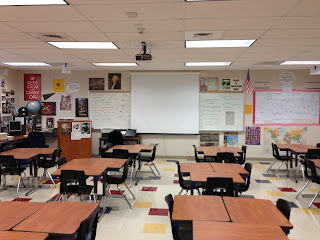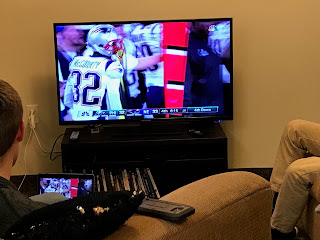(Re)Imagined Classroom
1. Classroom images
This image shows the desks arranged in groups. I want the focus of the student to be on each other and not me. (The class will still be didactic but I don't want to down-play my role as the teacher) By putting the desks in groups, the students will have to look at each other and it help in group work and discussions (image from here).


This image shows a bookcase with lots of different kinds of books. This is the bookcase I imagine in my classroom. Because I will teach English, I want to make sure that everything focuses on the enrichment of the students. There shouldn't be much time for them to goof off--if they don't have an assignment to do, they can read (The books will be from all different authors [gender, race, ethnicity, sexuality] representing all different kinds of people) (image from here).

2. Imagine the surrounding in your classroom. What does the room look like? What resources are available for students? How are the resources used during the lesson?
- The classroom will be arranged in groups
with me at the back of the classroom.There will be a lot of books and the students will have writers' notebooks which they will use to do writing exercises at the beginning and to do practices during the lesson. They will have netbooks to use to type as well as to learn and use other types of writing genres (website building, etc.) (according to ability and interest). The classroom is organized and there is plenty of paper and pencils for the students. The walls will have posters about authors and English but things that are not the normal motivational slogans. I specifically want this poster: "Unfortunately, History Has Set The Record A Little Too Straight." Bare walls are boring and I think more distracting. I want decor that is stimulating but important (as well as representational of all kinds of people, families, abilities, genders, sexualities, races, ethnicities, etc.)
3. Describe the students in your classroom. What are their backgrounds? What are their interests? What are they doing during the lesson?
- I kind of imagine that I will teach at the high school I attended. If that's the case, I image that my students are pretty evenly split white and Latinx. I imagine that there will be wide ranges of interests--lots of athletes, art kids, a large agricultural group, band, musical theatre, STEM, etc. Their financial backgrounds vary widely as well. There is only one high school in the district so there are students from really affluent families and others that are in poverty.
4. Describe your classroom policies. What are your classroom rules? What is your discipline plan? What are your homework policies?
- My classroom policies are to respect other's points of view and comments, take risks and have fun.
I will work with the students to come up with the rules of the classroom; I feel that if they come up with them, they will follow them, provided of course that if need be, as a teacher, I have the power to veto rules. (As the teacher and the authority figure, I will decide the rules that best fit the classroom and students. Rules will have specific purposes and won't target individual groups of students). My discipline plan is to address issues when they are small, talking one-on-one with the student. We work together to figure out the root issue of the misbehavior and address that instead of punishing for the behavior (I will work to build a relationship with students so that we can talk openly and honestly about issues and hopefully build bridges across things that divide them from me as a grown, white man). Homework will be minimal, usually finishing things that are not finished in class. There may be assignments here and there based on observations, etc. but I won't assign much that cannot be done without the resources we have in class. Many of my students come from lower-income homes and many don't have internet access; I don't want to penalize students who cannot do homework because of economic situations.
5. Describe a typical lesson you will teach in your classroom. What will you teach? What is the topic? Why did you choose this topic? How will you teach it? What is the main thing you want students to learn during this lesson?
- A typical lesson will begin with reading something as a class--picture book, web article, etc. We will then have a writer's notebook about something related to that (like their opinion on an issue or coming up with a story similar to what we read). After a few students share their writing, we will jump into the material. It will be instruction built off of our larger portfolio--the lesson will be instruction, discussion and practice about a very specific facet or issue of the larger assignment, like how to identify and write for the audience of this paper by trying to sell it to a friend, teacher and grandmother, seeing how it changes each time. My teaching will be mostly pre-prep and then facilitating discussion. I will do small bursts of instruction but mostly it will be guided practice. The main thing they will be learning is the strategies of writing, that what we do will help with the larger assignment but also can be applied to writing situations outside the classroom.
6. Imagine your work as a teacher during this lesson. What are you doing during the lesson?
- At the beginning, I will introduce the concept through a though exercise. I will then ask questions to promote discussion. Next, I'll model the practice (using a lot of different examples to make sure everyone understands) then give instruction on the individual and group practice. While they are working, I will be there observing to make sure they're on task, offering help and asking about what they think.
I'll be more of a resource and guide than a lecturer.(I believe in didactic structure but I will be there to provide firm and solid instruction.)
7. Imagine your students again, what are they doing during the lesson?
- During the lesson, they are discussing--answering my questions but also asking
and answering each others. During the group work, they provide their own work to be discussed but each of them are giving insights that are founded on their specific backgrounds and interests. This gives a well-rounded discussion not dominated by my point of view. (While my point of view as a white man is not dominant, I will still be an authority figure in the classroom as the teacher; my role isn't to just sit back and nudge.)
8. Imagine how you will assess your students' learning and achievement. How will you know they have learned?
- I will review the practices they do in their writers' notebooks to see how they applied the ideas we reviewed in class. I will also do exit slips occasionally as a quick feedback to gauge for the day. I'll provide feedback on their final assignments to review their understanding of the strategies but allow them to revise based on my feedback and resubmit the assignments. (There will be a lot of different types of assignments, and even within the same "assignments" students will have a lot of autonomy about choosing what they want to focus on--ie, we may have an assignment about persuasive essays but students will choose their point of view and perhaps how they want to present the information. it will all be based on ability and what they are familiar with. I don't think that judging whether or not a student can write is a good indicator of whether or not they understand how to present an argument. While writing is important, and we will work on that, various modes of presentation will be available).
Reflection
- I made a lot of changes based on what we talked about in class over the course of the semester. Rather than talking about them one by one, I'll discuss the big ideas behind why I made changes. (For your reference, the strike-through shows where I cut out things and the smaller parenthetical asides show where I added). The first big idea behind my changes was my role as a teacher. I based most of my original ideas on my role being a guide and not an authority. It should be self discovery and I would just nudge. Wrong. I realized that though my ideas were based on research into childhood psychology, all the studies were done on white children! It works for them because that is how they are raised--the parents give suggestions instead of commands. So I changed my role to be more authoritative. I don't want to be authoritarian but have a strong adult figure is more in line with how many minority children are raised and will provide a more clear direction in the classroom for them. The white students may be less familiar but it won't be harmful to them. Plus, minority students have had to adapt all throughout their lives; making white students adapt won't kill them. The other big idea behind my changing was organization. I thought that everything should be cut and dry--I give assignments, they write and turn the assignments back in. But I realized that doesn't work very well for students with different abilities. They may not be writing much and could instead have other ways they present information (videos, voice recordings, etc.). The way I had my assignments organized just didn't work for them. So, I scrapped that in favor of a more flexible, one on one kind of idea. One way or another, I will assess students' work; we'll figure that out when we get to each student. Another thing that gave a big change was representation. I realized that in my first classroom, I didn't have anything explicitly saying that I would represent all kinds of people. I changed it to explicitly say that I will have authors that all kinds of folks and my classroom decor will reflect that as well. I want everyone to be represented: genders, race, ethnicity, ability, sexuality, etc. All kinds of people write and we can study all kinds of people. Along with that, I wanted to more explicitly say that students will be able to adjust their assignments based on ability as well--some students may not be as strong in writing in general or in English specifically. While I do need to give writing instruction, I want to provide a way for students to still demonstrate the skills of writing in a way that doesn't target them to fail. In writing a persuasive essay, for instance, the importance is arguing your point and supporting your claim. There are a lot of ways to do that outside of a tradition 5 paragraph essay. And I will be open to all of those. Students will be explicitly given autonomy to work in a way that works for them. I also made changes based on my privilege as a grown, white man. It may be difficult for students to be comfortable with me asserting authority as someone in my status. I want to make a concerted effort to reach out to students as individuals and work to build bridges. I will also use my privilege to create change for oppressed people. Finally, my biggest change is that I am open to more change. I will be constantly trying to evaluate myself to see what works and what doesn't. Each class is going to be different and I want to make sure that I work with them and not impose what I think is right onto them.



Comments
Post a Comment